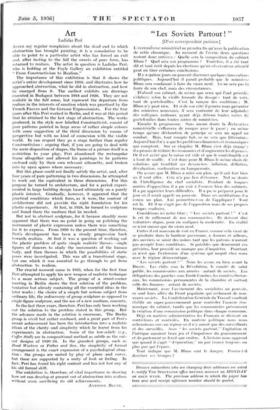Art
Ladislas Peni ArrEE my regular complaints about the dead end to which abstraction has brought painting, it is a consolation to be able to point to a particular artist who has forced an exit and, after tasting to the full the sweets of pure form, has returned to realism. The artist in question is Ladislas Pen, who is holding at the Foyle Gallery an exhibition entitled
From Constructivism to Realism."
The importance of this exhibition is that it shows the artist's entire development since 1918, and illustrates how he approached abstraction, what he did in abstraction, and how he emerged from it. The earliest exhibits are drawings executed in Budapest between 1918 and 1920. They are not realistic in the full sense, but represent the departure from realism in the interests of emotion which was practised by the French Fauves and the German Expressionists. For the four years after this Pen worked in Berlin, and it was at this period that he attained to the last stage of abstraction. The works produced, in the style now labelled Constructivist, consist of pure patterns painted in large areas of rather simple colours with some suggestion of the third dimension by means of perspective but with no kind of connexion with the visible world. In one respect they go a stage further than regular Constructivism : arguing that, if you are going to deal with the mere disposition of shapes, the frame of a picture itself is a restriction to your play, Pen i abandoned the rectangular frame altogether and allowed his paintings to be patterns enclosed only by their own relevant silhouette, and broken into by open spaces where necessary.
But this phase could not finally satisfy the artist, and, after four years of pure patterning in two dimensions, he attempted to work out the equivalent in three dimensions. For this purpose he turned to architecture, and for a period experi- mented in large building design based ultimately on a purely plastic interest. Gradually, however, it appeared that the practical conditions which form, as it were, the content of architecture did not provide the right foundation for his plastic experiments. At last, in 1928, he turned to sculpture and found there the medium that he needed.
But not in abstract sculpture, for it became steadily more apparent that there was no point in going on polishing the instrument of plastic expression unless there was something for it to express. From 1930 to the present time, therefore, Penis development has been a steady progression back towards realism. At first it was a question of working out the plastic problem of quite simple realistic themes—single figures of dancers to study the movements of the human body, and then themes in which the possibilities of static poses were investigated. This was all a transitional stage, but one which it was essential to go through to get from abstraction to realism.
The crucial moment came in 1933, when for the first time Pen i attempted to apply his new weapon of realistic technique to a more serious subject. The group of a street-corner meeting in Berlin shows the first solution of the problem, tentative but already containing all the essential ideas in the later works : the choice of a simple but serious subject from ordinary life, the rediscovery of group sculpture as opposed to single-figure sculpture, and the use of a new medium, concrete.
In the last three years, therefore, Pen i has only been working out the solution to the problem stated in this group. But the advance made in the solution is enormous. The Berlin group is vivid but rather confused, and a great part of Peri's recent achievement has been the introduction into a realistic idiom of the clarity and simplicity which he learnt from his experiments in abstraction. Some of the low-reliefs (e.g., Coffee Stall) are in compositional method as subtle as the cut- out designs of 1920-24. In the grandest groups, such as Road Workers or Father and Son, the simplicity of formal arrangement is the exact expression of a psychological situa- tion : the groups are united by play of plane and curve, but these are supported by a unity of look or feeling. In fact, Pen i has found his right content and has not lost any of his old formal skill.
The exhibition is, therefore, of vital importance in showing how art can develop at present out of abstraction into realism Without even sacrificing its old achievements.
ANTIIONY BLUNT.














































 Previous page
Previous page